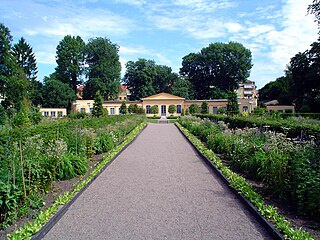
In biological classification, subspecies is a rank below species, used for populations that live in different areas and vary in size, shape, or other physical characteristics (morphology), but that can successfully interbreed. Not all species have subspecies, but for those that do there must be at least two. Subspecies is abbreviated as subsp. or ssp. and the singular and plural forms are the same.

In biology, a subgenus is a taxonomic rank directly below genus.

In biology, a tribe is a taxonomic rank above genus, but below family and subfamily. It is sometimes subdivided into subtribes. By convention, all taxa ranked above species are capitalized, including both tribe and subtribe.
In biology, trinomial nomenclature is the system of names for taxa below the rank of species. These names have three parts. The usage is different in zoology and botany.

The International Code of Nomenclature for algae, fungi, and plants is the set of rules and recommendations dealing with the formal botanical names that are given to plants, fungi and a few other groups of organisms, all those "traditionally treated as algae, fungi, or plants". It was formerly called the International Code of Botanical Nomenclature (ICBN); the name was changed at the International Botanical Congress in Melbourne in July 2011 as part of the Melbourne Code which replaced the Vienna Code of 2005.

In botanical nomenclature, a form is one of the "secondary" taxonomic ranks, below that of variety, which in turn is below that of species; it is an infraspecific taxon. If more than three ranks are listed in describing a taxon, the "classification" is being specified, but only three parts make up the "name" of the taxon: a genus name, a specific epithet, and an infraspecific epithet.

In botany and plant taxonomy, a series is a subdivision of a genus, a taxonomic rank below that of section but above that of species.
In mycology, the terms teleomorph, anamorph, and holomorph apply to portions of the life cycles of fungi in the phyla Ascomycota and Basidiomycota:

A botanical name is a formal scientific name conforming to the International Code of Nomenclature for algae, fungi, and plants (ICN) and, if it concerns a plant cultigen, the additional cultivar or Group epithets must conform to the International Code of Nomenclature for Cultivated Plants (ICNCP). The code of nomenclature covers "all organisms traditionally treated as algae, fungi, or plants, whether fossil or non-fossil, including blue-green algae (Cyanobacteria), chytrids, oomycetes, slime moulds and photosynthetic protists with their taxonomically related non-photosynthetic groups ."

In biological nomenclature, a syntype is any one of two or more biological types that is listed in a description of a taxon where no holotype was designated. Precise definitions of this and related terms for types have been established as part of the International Code of Zoological Nomenclature and the International Code of Nomenclature for algae, fungi, and plants.

Altingiaceae is a small family of flowering plants in the order Saxifragales, consisting of wind-pollinated trees that produce hard, woody fruits containing numerous seeds. The fruits have been studied in considerable detail. They naturally occur in Central America, Mexico, eastern North America, the eastern Mediterranean, China, and tropical Asia. They are often cultivated as ornamentals and many produce valuable wood.
Nomenclature codes or codes of nomenclature are the various rulebooks that govern the naming of living organisms. Standardizing the scientific names of biological organisms allows researchers to discuss findings.
In botany, the correct name according to the International Code of Nomenclature for algae, fungi, and plants (ICN) is the one and only botanical name that is to be used for a particular taxon, when that taxon has a particular circumscription, position and rank. Determining whether a name is correct is a complex procedure. The name must be validly published, a process which is defined in no less than 16 Articles of the ICN. It must also be "legitimate", which imposes some further requirements. If there are two or more legitimate names for the same taxon, then the correct name is the one which has priority, i.e. it was published earliest, although names may be conserved if they have been very widely used. Validly published names other than the correct name are called synonyms. Since taxonomists may disagree as to the circumscription, position or rank of a taxon, there can be more than one correct name for a particular plant. These may also be called synonyms.
Werner Rodolfo Greuter is a botanist. He was the chair of the Editorial Committee for the International Code of Botanical Nomenclature (ICBN) - the Tokyo Code (1994) and the St Louis Code (2000). His proposed policy as regards registration of botanical names proved unpopular and in 1999 he stepped back, not being elected anew: he completed his term as chair to be succeeded at Vienna in 2005. He returned as a member of the editorial committee, contributing to the renamed International Code of Nomenclature for algae, fungi, and plants, the "Melbourne Code" (2012).
A cultigen, or cultivated plant, is a plant that has been deliberately altered or selected by humans, by means of genetic modification, graft-chimaeras, plant breeding, or wild or cultivated plant selection. These plants have commercial value in horticulture, agriculture and forestry. Plants meeting this definition remain cultigens whether they are naturalised, deliberately planted in the wild, or grown in cultivation.

Loropetalum is a genus of four species of shrubs or small trees in the witch-hazel family, Hamamelidaceae, native to China, Japan, and south-eastern Asia.

Loropetalum subcordatum is a species of plant in the Hamamelidaceae family. It is found in China and Hong Kong. Previously considered a separate genus, Tetrathyrium, Loropetalum subcordatum is one of four species of Loropetalum, and is placed in tribe Loropetaleae, subfamily Hamamelidoideae, family Hamamelidaceae of the Saxifragales. Its conservation status is considered vulnerable.
Phytotaxa is a peer-reviewed scientific journal for rapid publication on any aspect of systematic botany. It publishes on a wide range of subjects, but focuses on new species, monographs, floras, revisions, reviews, and typification issues. Phytotaxa covers all plant groups covered by the International Code of Nomenclature for algae, fungi, and plants, including diatoms, fungi, algae, lichens, mosses, hornworts, liverworts, and vascular plants), both living and fossil.

In mycology, a sanctioned name is a name that was adopted in certain works of Christiaan Hendrik Persoon or Elias Magnus Fries, which are considered major points in fungal taxonomy.

Disanthus cercidifolius is a species of flowering plant in the family Hamamelidaceae. It is native to woodland habitats in China and Japan.












